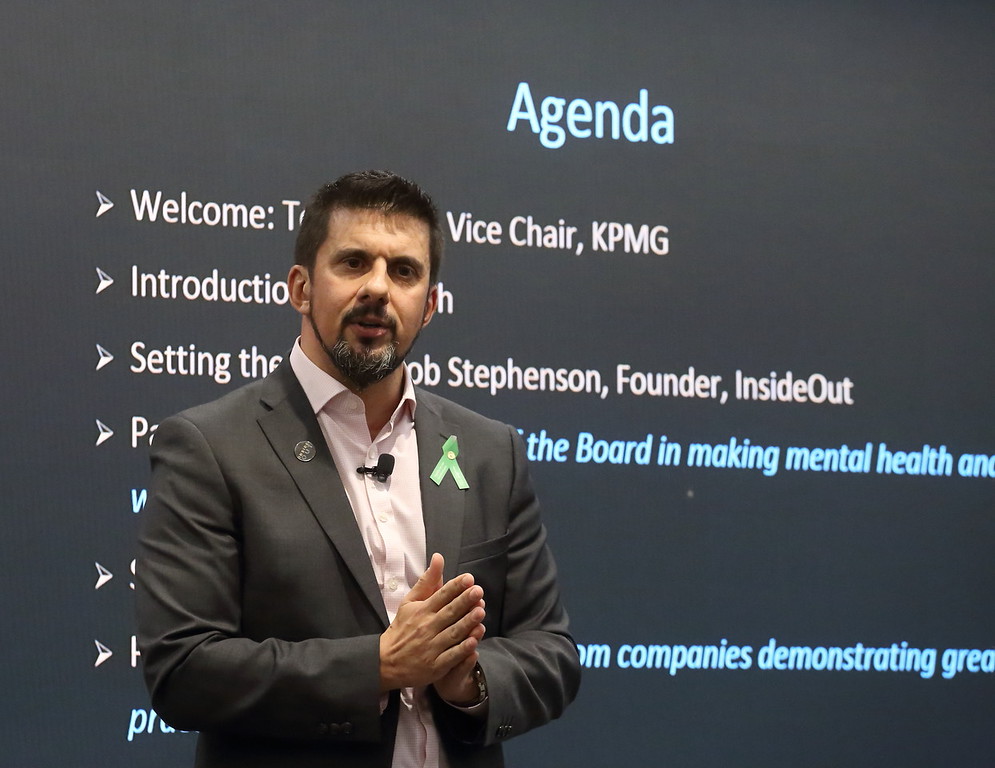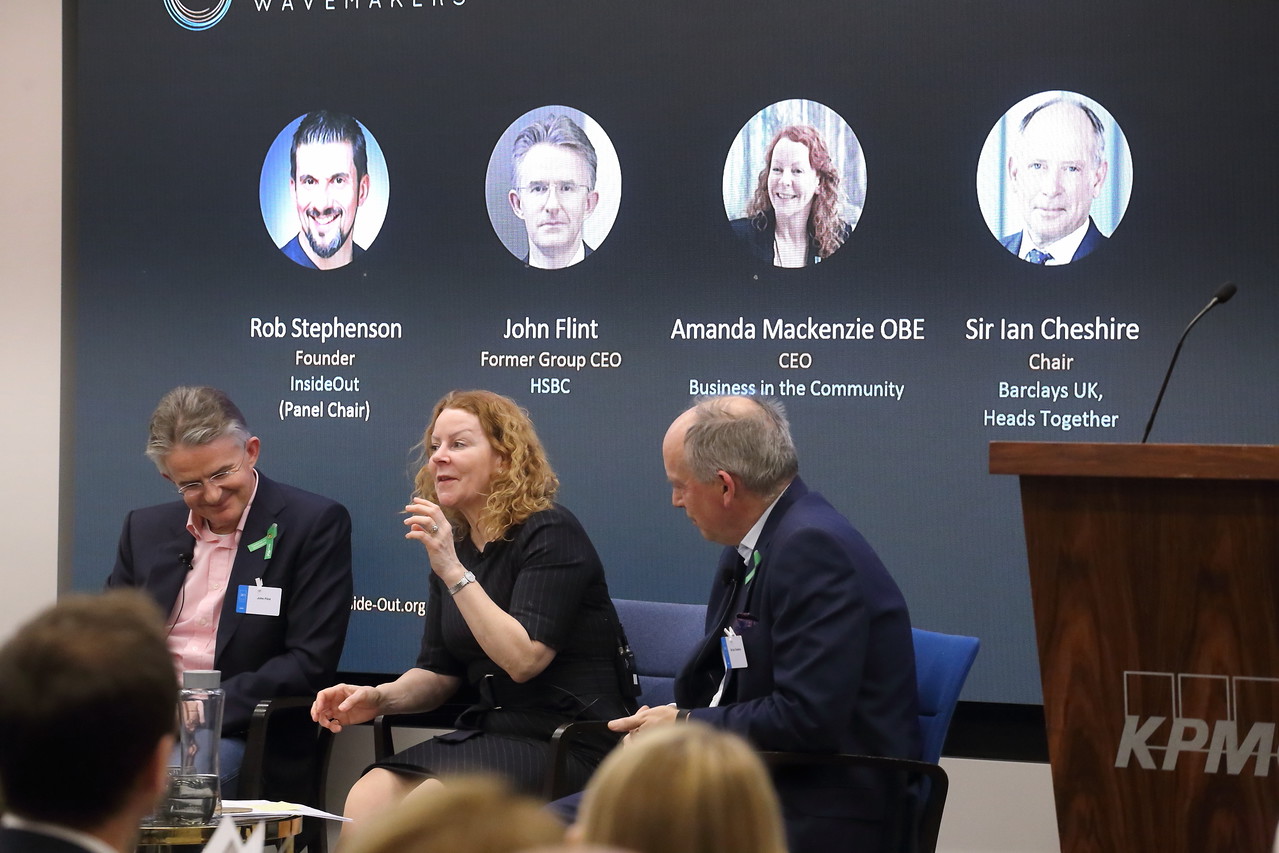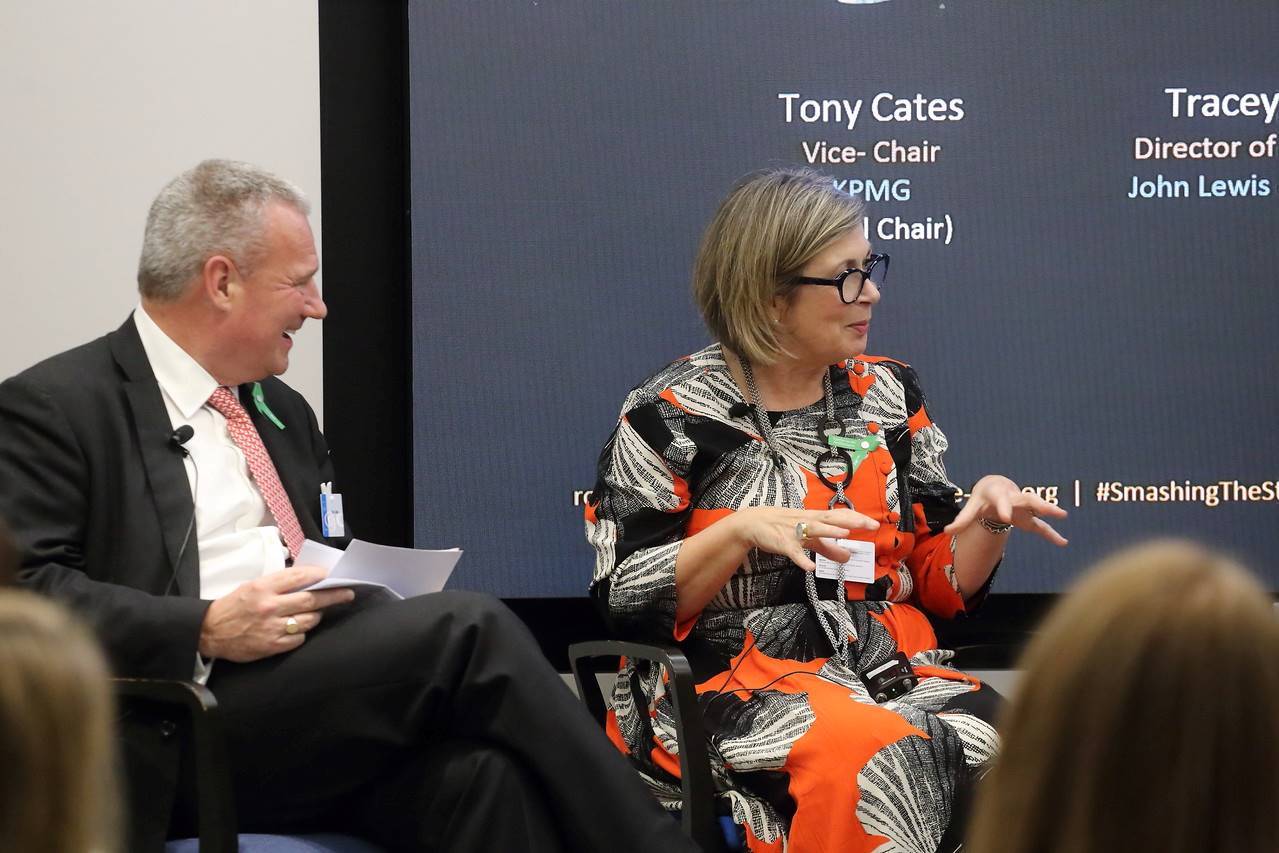Recently published analysis found that poor mental health costs UK businesses up to £45 billion each year – a rise of 16% since 2016. Rob Stephenson, Founder of InsideOut is a campaigner for creating healthier workplaces. Rob describes mental health as one of the big challenges of our lifetime along with climate change, habitat destruction and overconsumption.
So how do we capitalise on this £45 billion opportunity? And what is the role of the board and the executive committee in really pushing the mental health agenda forwards?
To explore these questions, InsideOut partnered with Savannah Group for an event hosted at KPMG to bring a room of senior executives together to educate and inspire about the opportunities addressing mental health in the workplace can bring.

InsideOut assembled a panel of prominent business leaders and mental health advocates including Tony Cates (Vice Chair, KPMG); Sir Ian Cheshire (Chair, Barclays UK and Heads Together); John Flint (Former Group CEO, HSBC); Tracey Killen (Director of Personnel, John Lewis & Partners); Amanda Lambert (People Director, Three); Amanda Mackenzie OBE (CEO Business in the Community); and Andy Brown (Head of Sustainability, Anglian Water).
The audience, made up of Board level executives, NEDs and senior HR executives, were fully involved in the event from the start with some engaging discussion around their own mental form score before the panels were convened.
Why should we make mental health a priority?
The recent report by Deloitte on the case for investment in mental health found that for every £1 spent by employers on mental health interventions, they get £5 back in reduced absence, presenteeism and staff turnover.
Additionally, when people were asked what the biggest drivers were for negative mental health, 39% said that their work contributed to their ill mental health. As Amanda Mackenzie OBE explains “If you assume mental health is on par with physical health and you had a physical issue at that scale the world would grind to a holt.” Prioritising mental health should not only be a leadership priority but is a moral imperative.

A leadership role is nothing more than creating an environment where people can be their best. John Flint, former Group CEO of HSBC describes it as an imperative for leaders not only because it’s the right thing to do, but to safeguard against the inevitable workforce changes through technology. He explains “Think about how the workforce is evolving. Soon all the simple jobs will be automated which means fewer human beings but more critical roles. If that’s the case, then you better make sure that those human beings making those critical decisions are at their best.” While mental wellness can be outsourced to the HR function that will only get you so far. For a company’s culture and attitude towards mental wellness to radically improve, all leaders should be active.
In a lot of ways, employees should be on the balance sheet in the same way as cash explains Andy Brown of Anglian Water. “Water businesses are long-term infrastructure business, so if you have a plan to maintain your pipes and production facilities that you have to look after, why wouldn’t you do exactly the same thing for your people?”
For Anglian Water, the moment of truth came when they saw their medical costs soaring by 10% each year. “The board looked at that and said what should we do?” explains Andy. The easy thing to do would have been to reduce the medical package and benefits, but instead the board decided they would look at how they can improve the business. Andy continues “Being an infrastructure business, it comes as a surprise to a lot of people when we say that the most important asset in our business are our people, but if you start to address wellbeing then you get paid back many, many times from that asset.”
“Mental ill-health is one of the biggest causes of absenteeism” agrees Sir Ian Cheshire, Chair of Barclays UK, and the payback is quite quick. In the last five years the dialogue has changed to focusing on getting the best out of people, and proactively keeping them engaged and healthy is a much better idea than letting them get to a stage where damage recovery is needed. “It’s time for leaders to own this and we have a duty to our employees to help them get better.”

Why are we not doing more?
A stigma still exists and for many businesses it’s about coming out and saying it’s ok to not be ok. “The question leaders need to ask themselves” says Sir Ian “is how is your business contributing to this problem?” Unfortunately, in many businesses there is still a lack of confidence about raising the topic of mental health and discussing it.
“There’s a degree of fear, people not feeling comfortable about talking about mental health” agrees Amanda Mackenzie. A staggering statistic is that only 13% of employees who experienced poor mental health as a result of work raised this with their line manager. “Ironically” Amanda points out “businesses are the last to react. We’ve had sports stars and TV personalities come out and speak openly about their mental health challenges, but persuading business leaders to be open has proven much more difficult.”
Part of this is an exposure problem, with business leaders worried about negative repercussions if they do speak up. It’s much easier to talk about a physical ailment so it takes more confidence to come forwards. The encouragement and support networks need to be there for people to be more proactive.
From a regulatory point of view all of the panel agreed that taxing company-provided mental health support as a benefit in kind is an antiquated idea and more lobbying is needed for the government to address this. The tax rules about in-house mental health provision are around 15 years old and the Working Well Coalition want them updated. They are asking the government to simplify the tax rules and not penalise people who ask for help. They believe that if these tax changes were made it would incentivise other great organisations to do a lot more.

Unfortunately, there is still a stigma that a person will be penalised for opening up about a mental health issue. John Flint vehemently disagrees with this saying “people who have been through a mental health issue have had to be incredibly resourceful in order to get through the challenges they have faced.” He continues “they have a different perspective to people who have never experienced mental ill health and therefore they are a true asset to any business. It’s incredibly short-sighted to penalise someone purely on that basis.”
How do you get buy in?
Contrary to many preconceptions, it doesn’t take much energy to persuade the board, and all of our panellists found it straightforward to encourage their board that it was the right thing to do. With HSBC, John’s vision was to create the healthiest human system in Financial Services. Once that vision was established, a strategy was then developed to make it happen with every person in HSBC. John warns however “It’s not about pushing this back up to the board. While you need the initial nod from them, they are too far removed to drive it. This is an executive challenge, so they need to own it.”
Starting a movement
The question for any business is how do you get the best out of your total collective leadership? For starters, you need to ensure people are comfortable bringing their whole self to work and that you’re not mistreating them, burning them out, or unduly stressing them through progression reviews and performance reviews.

Amanda Lambert, People Director at Three explains that to kick off their mental health initiative the leadership team shared a story each day about their mental health. They ran the initiative for a week with two board members coming forward and openly talking about their mental health issues. Amanda explains “The plan was to only run it for a week, but after these stories came out we continued it for another week as others in the organisation had been inspired and wanted to come forwards to share their story too.” “Still today” Amanda continues “I bump into new faces in the lift and they know me from my mental health story and tell me about how it touched them or an anecdote about someone they know struggling with similar issues. It’s amazing really”.
John Lewis & Partners have also been pioneers for improving employee mental health. Tracey Killen, Director of Personnel explains that they started by asking and encouraging people to be open about their mental health. For John Lewis & Partners there’s also a strong business case. Tracey continues “The great battleground for recruiting brilliant people and letting them do their best work is creating an environment where they can be their best selves.” As a company, they focused on sharing stories about what happened to an individual but also what they did to help address it. By ensuring there is practical guidance within the story, it helps people see what changes they could make and take control.

Starting a movement in your organisation is key and John Lewis & Partners learnt that for 2/3rds of the people coming forwards, they were already out of work struggling with an issue. Because of the support they’ve put in place, just 4% now stay out of work.
“Sharing your story is the single most powerful thing you can do” Andy Brown agrees.
Mental health initiatives that don’t cost the earth
John Lewis & Partners
Tracey Killen from John Lewis explains that they took a three-pronged approach once they had the data and knew they needed to do something about it.
• Firstly, they kicked off an initiative called ‘really good work’ which asked the question ‘are we designing work well?’ They then looked further at how they construct work and the components.
• Secondly, they identified they needed more opportunities for growth. “People felt that they weren’t getting better every day or contributing more so we looked at how we can make those positions more powerful.”
• Thirdly, they started a movement by giving 170 branches a small pot of money and encouragement to make their environment better. “Sometimes you’ll see 400 people at 8am dancing in a store – it’s quite a sight!” laughs Tracey. In addition, John Lewis & Partners have a health team who helps support these branches along with their app, unwind, which is used by 8,000 people. “It’s about providing opportunity for social connection, outside of their routine” says Tracey.
Three
Amanda Lambert explains that at Three, they spend a pound per week per person, yet wellness is the most demanded benefit in every survey they run. Some of the concerns often cited are a meeting culture, not being able to take a break and juggling work and life. Their “Wellness Wednesday” initiative runs between midday and 2pm where their employees set up lunch clubs, film clubs and other get togethers. “It doesn’t cost anything” says Amanda “and brings people together.”
Anglian Water
“For us at Anglian Water” explains Andy “getting out and talking about it while enabling people to find the time to do just that is what it’s about”. “Some employees run drop-in sessions and really we just support them in doing what they want to do.” Another area they addressed was being able to self-refer, largely based on Andy’s own personal experiences when he wanted to come forward about his own challenges. Since setting up a self-referral scheme at Anglian, the average days of absenteeism through mental health has dropped from nineteen days to seven.

Andy’s view is that mental wellness should quickly just become a hygiene issue so that it can be moved on to the next level. “We’ve got to smash the stigma” says Andy “and as an example for how we’re trying to do this, in July our board changed our articles of association to put social and environmental support in their region within it.” Wellbeing is clearly tied into that and similar to Amanda’s experience at Three, it’s the number one response in terms of what employees within the organisation value most. Andy says that they now take a wider value approach to the way they make decisions, whatever they may be. They ask themselves ‘How does that empower people to feel good about what their doing?’ Anglian Water want to be known for being happy, healthy and safe.
How do you implement mental health initiatives in businesses of scale?
The Stevenson Farmer report sends a clear signal that the government is behind mental health. The next step is to be pragmatic about where in the workplace this needs to be addressed. “In the same way you do a physical risk assessment and say, ‘you can’t do that” explains John “we need to do the same for mental health.”
“The initiative has to be owned by the executive and preferably the chief exec.” John continues, “Most big human systems become hierarchical over time. Getting good employee insight, finding out the stuff that you probably really don’t want to know and then being transparent with the staff afterwards is what’s needed.”
“It requires courage and vulnerability” says Sir Ian. “It requires some measurement about mental health or mental form and the aim is just to move it on.” He points out that if you don’t have data it becomes difficult to do anything productive. It must be authentic however otherwise it will bounce of the organisation and fail. “People can spot a lack of authenticity a mile off” he concludes.

“Once you get started” John says, “be very aware of the framework from head office. You have to be careful that an Anglo-Saxon view of the world doesn’t cascade down into an Asian company. And if it does, good luck!” Ian agreed explaining that different countries will be enthusiastic, but they’ll want to do it in their own way. “Grassroots shouldn’t be too much of a problem” continues Ian “it’s getting it through the permafrost middle which is the tricky part, so leaders need to find the anecdotes and methods to get through.”
How do you measure success?
Anglian used a ROI calculator for wellbeing and it surfaced an 8 to 1 benefit, but they quickly realised that it’s not about chasing the numbers. They still measure stats, but they don’t allow them to drive the change in behaviour. Instead they track how quickly they get someone into referral and the severity of symptoms etc.
Three on the other hand purposely don’t want to measure with an ROI so they measure on engagement with frequent surveys. They use an internal NPS score and are only interested in whether it is trending in the right direction.
What next?
The business case is compelling, so the challenge is how do you make a difference. When people are at their most vulnerable, the people they most often turn to is their partners, so it’s important there is support for them too. With different generations at work it does make running initiatives a bit more complicated but re-emphasises that not one size will fit all. Businesses need to find the types of initiative that work for them, and with an increasing number of people in the future facing these issues, we need to give middle managers the confidence and support to be able to direct people to the help they need rather than making them psychologists.

Tangible Actions
Two tangible initiatives were discussed by the panel:
- The InsideOut Leadership Charter – a set of principles based on the Stevenson-Farmer review that Leaders and their organisations can sign up to in order to ensure that the mental health of employees is treated as a strategic priority
- Mental Health at Work Commitment – a framework, also based on Stevenson-Farmer, and a roadmap to achieving better mental health outcomes for employees
Rob Stephenson’s call to action:
“Let’s ask people how they are today. Let’s engage our CEOs. Let’s share our own stories about mental health. Let’s smash the stigma and support and encourage others who want to do the same. Let’s not be afraid of getting things wrong. Let’s start a movement.”
About InsideOut
Inside Out are global mental health campaigners and consultants working with leadership teams on helping organisations treat mental health as a strategic priority alongside the design and implementation of an integrated mental health and wellbeing strategy.
The InsideOut LeaderBoard showcases senior leader role models who are open about their challenges of mental ill-health and the InsideOut Awards celebrates those who are championing employee mental health.
Founder, Rob Stephenson, is an international keynote speaker on mental health in the workplace and CEO of Form, a mental health start-up that helps employees answer the question: “How are you today?”.
If you are interested in finding out more, please contact Rob at rob@inside-out.org




